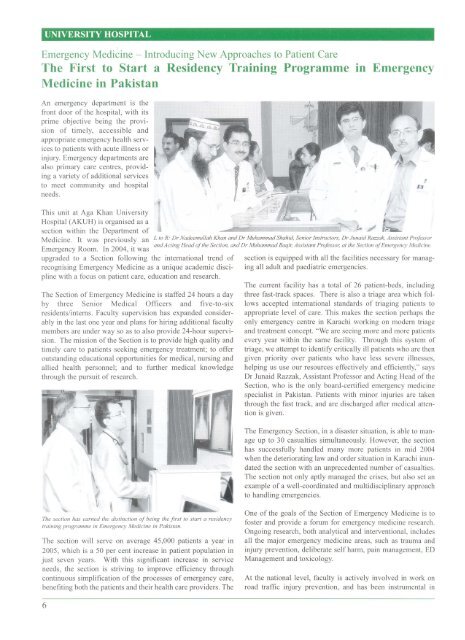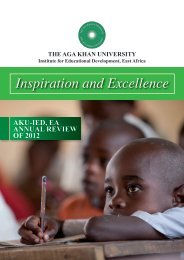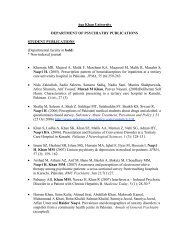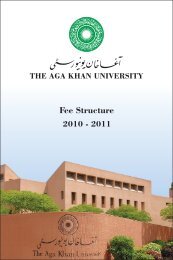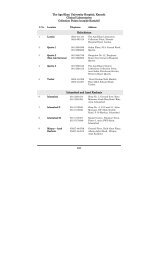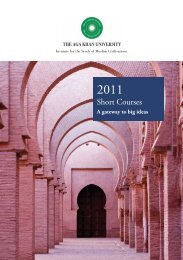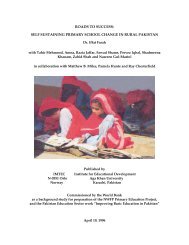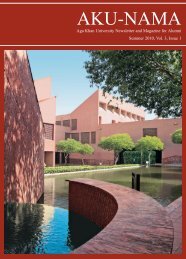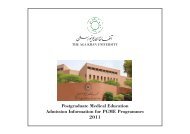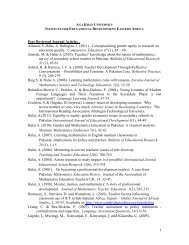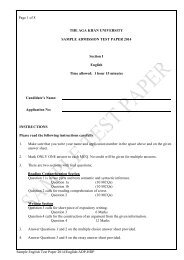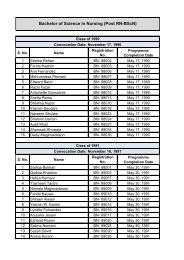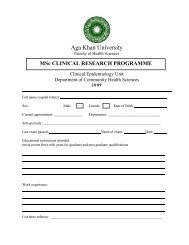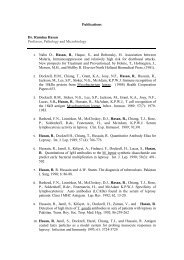Emergency Medicine - Aga Khan University
Emergency Medicine - Aga Khan University
Emergency Medicine - Aga Khan University
You also want an ePaper? Increase the reach of your titles
YUMPU automatically turns print PDFs into web optimized ePapers that Google loves.
'UNIV ERSITY HOSPITAL I • ,' ,<br />
<strong>Emergency</strong> <strong>Medicine</strong> - Introducing New Approaches to Patient Care<br />
The First to Start a Residency Training Programme in <strong>Emergency</strong><br />
<strong>Medicine</strong> in Pakistan<br />
An emergency department is the<br />
front door of the hospital, with its<br />
prime objective being the provision<br />
of timely, accessible and<br />
approp riate emergency health services<br />
to patients with acute illness or<br />
injury. <strong>Emergency</strong> departments are<br />
also primary care centres, pro viding<br />
a var iety of additional services<br />
to meet community and hospital<br />
needs .<br />
The Section of <strong>Emergency</strong> <strong>Medicine</strong> is staffed 24 hour s a day<br />
by three Senior Me dica l Officers and five -to-six<br />
residents/interns. Faculty supervision has expanded considerably<br />
in the last one year and plans for hiring additio nal faculty<br />
members are under way so as to also provide 24-h our supervi <br />
sion . The mission of the Section is to provide high quality and<br />
timely care to patients see king emergen cy treatm ent; to offer<br />
outstandi ng educational opportunities for medical, nursing and<br />
allied hea lth personnel; and to further medic al knowledge<br />
through the pursuit of research.<br />
~'<br />
1<br />
This unit at <strong>Aga</strong> <strong>Khan</strong> Universi ty<br />
Hospital (AKUH) is organ ised as a i~<br />
section withi n the Department of :II<br />
<strong>Medicine</strong>. It was previously an L to R: Dr Nadeemullah <strong>Khan</strong> and Dr Muhammad Shahid, Senior Instructors, Dr Junaid Razzak, Assistant Professor<br />
and Acting Head ofthe Section, and Dr Muhammad Baqir; Assistant Prof essor,at the Section of<strong>Emergency</strong> <strong>Medicine</strong>.<br />
Emerge ncy Room. In 2004, it was<br />
upgraded to a Section follo wing the international trend of<br />
recog nising <strong>Emergency</strong> Medi cine as a unique academic discipline<br />
with a focus on patient care, education and research .<br />
section is equipped with all the facilities necessary for managing<br />
all adult and paediatric emergencies .<br />
The current facility has a total of 26 patient-beds, including<br />
three fast-track spaces. There is also a triage area which follows<br />
accepted international standards of triaging patients to<br />
appropriate level of care. Thi s makes the section perhaps the<br />
only emergency centre in Karachi working on modern triage<br />
and treatm ent concept. "We are seeing more and more patients<br />
every year within the same facility. Through this system of<br />
triag e, we attempt to identi fy critically ill patients who are then<br />
given priority over patients who have less seve re illnesses,<br />
helping us use our resources effectively and efficiently," says<br />
Dr Junaid Razzak, Assistant Professor and Acting Head of the<br />
Section, who is the only board-certifi ed emergency medicine<br />
specialist in Pakistan . Patients with minor injuries are taken<br />
through the fast track, and are discharged after medical attention<br />
is given .<br />
The <strong>Emergency</strong> Section, in a disaster situation, is able to manage<br />
up to 30 casualties simultaneously. However, the section<br />
has successfully handl ed many more patients in mid 2004<br />
when the deterioratin g law and order situation in Karachi inundated<br />
the section with an unprecedented numb er of casualties.<br />
The section not only aptly managed the crises, but also set an<br />
example of a well-coo rdinated and mult idisciplinary approach<br />
to handling emergencies.<br />
I<br />
The section has earned the distinc tion of being the first to start a residency<br />
training programm e in <strong>Emergency</strong> <strong>Medicine</strong> in Pakistan.<br />
The section will serve on average 45,000 patients a year in<br />
2005, which is a 50 per cent increase in patient popul ation in<br />
just seve n years . With this significant increase in service<br />
needs , the section is striving to impro ve efficie ncy through<br />
continuous simplification of the proc esses of emergency care,<br />
benefiting both the patients and their health care providers. The<br />
One of the goals of the Section of Emerge ncy <strong>Medicine</strong> is to<br />
foster and provide a forum for emergency medicine research .<br />
Ongo ing resea rch, both analytical and interve ntional , includes<br />
all the maj or emerge ncy medicine areas , such as traum a and<br />
injury prevention, delib erate self harm , pain management, ED<br />
Management and toxicology.<br />
At the national level, facult y is actively involved in work on<br />
road traffic injury prevention, and has been instrum ental in<br />
6
, . ' UNIVERSITY HOSPITAL<br />
founding the<br />
Pakistan Society<br />
for <strong>Emergency</strong><br />
<strong>Medicine</strong>, which<br />
held its first<br />
meeting in 2005<br />
at AKUH . One<br />
of the faculty<br />
members is on<br />
the World Health<br />
O rga nization 's<br />
Steering Committee<br />
on<br />
<strong>Emergency</strong> and<br />
Trauma Care. Qualified nursing staff, including registered nurses<br />
The faculty also and other paramedics, fo rms the standard nursing<br />
serves as peer model at the section.<br />
reviewers for<br />
different international journals. Like other departments of the<br />
<strong>University</strong>, the section gains much from research collaborations<br />
with a number of international universities. The section<br />
recently obtained the NIH/Fogarty Center grant for research<br />
training in trauma researchers in Pakistan in collaboration with<br />
Johns Hopkins <strong>University</strong>.<br />
On the education front, the section has earned the distinction<br />
of being the first to start a residency training programme in<br />
<strong>Emergency</strong> <strong>Medicine</strong> in Pakistan in 2000. "The section conducts<br />
basic life support courses at the time of induction of new<br />
interns , residents, and fellows ," observes Assistant Professor<br />
Dr Muhammad Baqir, who is trained in Family <strong>Medicine</strong> and<br />
commands extensive experience in <strong>Emergency</strong> <strong>Medicine</strong> practice,<br />
both in Pakistan, at AKUH , and Iran. Other faculty members<br />
are Dr Nadeemullah <strong>Khan</strong> and Dr Muhammad Shahid,<br />
both Senior Instructors. Dr Nadeemullah <strong>Khan</strong> is trained and<br />
board-certified in Internal <strong>Medicine</strong> from <strong>University</strong> of<br />
Illinois , Chicago, while Dr Muhammad Shahid is the first resident<br />
trainee of <strong>Emergency</strong> <strong>Medicine</strong> programme at AKU and<br />
in Pakistan. The nursing coverage in the section , counted as<br />
one of the best in the city, encompasses critical patient management,<br />
handling trauma patients and several other emergencies.<br />
Under the leadership ofNee mat Ahmed , Senior Assistant<br />
Manager, qualified nursing staff, including registered nurses<br />
and other paramedics, forms the standard nursing model at the<br />
section.<br />
The future looks exciting for the Section. Planning for expanding<br />
the current section capacity is in its final phases. The facility<br />
is expected to double the current patient care areas: there<br />
will be a separate paediatrics area, more resuscitation beds, and<br />
a state-of-the-art Clinical Decision Unit. A larger and familyfriendly<br />
waiting area will also help reduce congestion in the<br />
corridors and at the entrance. More faculty members are being<br />
recruited and special emphasis is being placed on research and<br />
teaching, to make this section the first and a model academic<br />
emergency medicine programme in Pakistan .•<br />
AKUH 's Patient Welfare Programme<br />
In Aid of the Needy<br />
Fifty-year-old Farida, a widow and the mother of five , led a<br />
hand -to -mouth exi stence with a monthly income averaging<br />
Rs.8,000 (US $ 133) brought home by two plumber sons.<br />
For a long time, Farida had not shared with her children the<br />
bouts of unea siness that continued to push her to the point<br />
ofemaciation. Often, the pain would reach excruciating levels,<br />
but she had resolved not to add to her children's worries<br />
. However, her endurance gave way to tears and visible<br />
discomfort that could not escape the attention of herchildren<br />
.<br />
One day, she had to be rushed to see a doctor in her 'katchi<br />
abadi' (shanty town) , who recommended that Farida should<br />
visit a hospital for a thorough check-up. She was finally<br />
brought to <strong>Aga</strong> <strong>Khan</strong> <strong>University</strong> Hospital (AKUH) in Karachi,<br />
where doctors diagnosed her with cancer of the cheek and<br />
advised mandibulectomy and neck dissection surgery. This<br />
verdict by the doctor threw the children into a state of total<br />
helpless desperation. On the one hand , it was their ailing mother,<br />
and on the other, the mounting financial worries. Farida was<br />
immediately admitted in AKUH, where the financial counsellor<br />
assured the family that the Hospital's Patient Welfare<br />
Programme would first assess their case and then provide the<br />
necessary support.<br />
The cost of hospitalisation<br />
and<br />
surgery amounted<br />
to Rs.234,066<br />
(US$ 3,900).<br />
Farida's children<br />
were able to generate<br />
Rs.38,000<br />
(US $634)<br />
through family \<br />
and friends. To<br />
their great relief,<br />
the Patient<br />
Welfare programme<br />
assisted<br />
\<br />
with Rs .70,220<br />
(US $1,170), and<br />
another Rs.125,000 (US $2,084) was provided by the<br />
Patients' Behbud (welfare) Society for AKUH , which receive s<br />
zakat contributions for the support of needy and deserving<br />
patients.<br />
This is just one of the many stories that illustrate how the<br />
<strong>University</strong> has been providing high quality care to poor and<br />
deserving patients since its inception in 1986. The Hospital's<br />
Patient Welfare Programme has disbursed over RS.l .22 billion<br />
(US $28 .21 million), benefiting 225,000 patien ts. AKUH<br />
stands firm in its principle of providing quality care and<br />
treatment to all patients, including those who are financially<br />
challenged.•<br />
7


